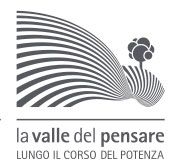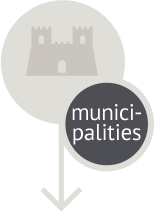The municipal building, called also “Prior’s Palace”, is the result of the perfect refurbishment made during the Renaissance time. It led to the fusion of two ancient buildings: the Community Palace and the Abundance Palace.
The fusion is evident in the particular shape of the pillars that support the arches of the portico: the first five pillars are very thin and of rectangular shape (they belong to the Community Building) while the other five are cross-shaped and wider (Abundance building). This architectonic peculiarity creates a singular prospective effect giving more depth to the building when observing it from the street Corso Italia. The fusion is more evident on the rear part, where the two buildings have kept their different heights and the Community building, higher than the other, includes the Civic Tower. Since the XVII century, the Abundance building included the Public Theatre that was demolished on the 30August 1780, as it was unstable.
The travertine frame protrudes on the earthenware tile of the vestments. The window gables are straight and tabernacle type at the second floor and alternatively triangular and curved at the first floor. The wrought iron braziers adorning the facade were made by Mario Vannucci of Treia in the first half of the XX century. In the hall and along the big stairs there are epigraphs and seals of popes and cardinals. On the ground and on the second floor of the building you can find municipality offices and the Mayor’s office, decorated in Liberty style and with wonderful furniture of the XIX century.
On the first floor, there is the Council Hall with a gorgeous fresco of 1928 in Liberty style made by painter Emilio Lazzaro. On the walls of this Hall there are nine canvas paintings of the XVII century representing Old and New Testament scenes, a Saint Michael the Archangel reproduced from the famous Guido Reni’s artwork and two paintings portraying two. angels.
The other rooms, used as Art gallery, show antique furniture of fine workmanship and paintings of prestigious painters belonging to Roman and Venice “schools” like Pietro Tedeschi (cent. XVIII), Antonio Balestra and Agostino Bonisoli (cent. XVII). A big painting of Bonisoli, depicting the martyrdom of the Franciscans protomartyrs at the hand of the King of Morocco and carefully restored to its original splendour only recently, overlooks the first of the Municipality building’s rooms.
THE FACADE
The main facade of the building was restored in 1760. During the restoration, the image of the Madonna of Loreto with the Holy House was put in the centre together with the writing “posuerunt me custodem”, bas-relief of the Roman sculptor Gioacchino Varlè. Very near to the support of the arches, there are eight cardinal’s blazons carved on stone, of which seven belong to the governors of Montecchio. The one in the centre, the biggest, represents Cardinal Nicola Grimaldi from Treia. He held important roles under Popes Pius VII, Leo XII, Pius VIII and Gregory XVI, who, in July 1832, appointed him as Governor of Rome.
THE CIVIC TOWER
A big bell is hung at the civic tower, it is key RE natural, and weighs 400 libers. It was constructed in 1761 by the caster Gian Battista Donati from the city of l’Aquila.
CURIOSITY
The first floor hosts the Room of Emblems. The roof’s cornice is formed by the emblems of the nobles of Treia: among the crest of the Ajanos’ family, gentlemen of the ancient castle reduced to few ruins, the crest of the Broglio-Masuccis’ family, who built a charming cottage shaped as a medieval tower, and the Grimaldi’s family crest, the Carlo Didimi’s emblem stands out. The celebrity of this man, as an athlete and a gentleman, has been eternalized by Giacomo Leopardi’s ode dedicated to him, and it still gives prestige to the town.
In the central rose window you can find the Emblem of the city: the three hills where Montecchio city rose, and two flower arising from them, two “liliums or poppies” as Dolores Prato, who spent her childhood in Treia, explains in her novel “Down the square the is no one”.







